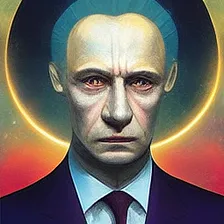
 Simplicius
Simplicius

| Resize text-+= |
The Empire Strikes Back - Launching Multi-Pronged Hybrid War Against Resistance Axis
Tbilisi now (people don't learn!—Ed)
Georgia Protests LIVE: Thousands Demonstrate in Georgia After Government Suspends EU Accession Talks
EDITOR: Apparently, neither Georgia, nor Moldova, nor Taiwan have learned anything from what happened to Ukraine.
Let’s start with the Israeli conflict, for which a ceasefire has been called. Hezbollah didn’t directly negotiate the ceasefire, but it was later said to be approved by acting head Naim Qassem. Hezbollah is supposed to withdraw units north of the Litani and Israel its own troops out of south Lebanon. Meanwhile, the Lebanese army has sent a peacekeeping force into the southern buffer area.
Israeli media: "Israel" will gradually withdraw its forces from south of the "Blue Line" in Lebanon within a period of up to 60 days.
Israeli Media Published the Full Ceasefire Agreement Between Israel and Lebanon, Which Includes the Following Terms:
1. Non-Aggression: Hezbollah and all other armed groups in Lebanon will refrain from initiating any offensive actions against Israel.
2. Israeli Commitment: Israel will abstain from conducting any offensive military operations against targets in Lebanon, whether on land, sea, or air.
3. Resolution 1701: Both nations affirm the significance of adhering to UN Security Council Resolution 1701.
4. Self-Defense: These commitments do not restrict either Israel or Lebanon from exercising their inherent right to self-defense.
5. Authorized Forces: Only Lebanon's official security and military forces are permitted to bear arms or operate in southern Lebanon.
6. Weapons Supervision: The sale, supply, and production of weapons and related materials for Lebanon will be overseen and regulated by the Lebanese government.
7. Dismantling Unauthorized Facilities: All unapproved facilities involved in weapon production or related activities will be dismantled.
8. Confiscation of Unauthorized Weapons: Military infrastructure and positions that do not align with the agreement will be dismantled, and all unauthorized weapons will be seized.
9. Monitoring Committee: A mutually agreed-upon committee will be established to monitor and support the enforcement of these commitments.
10. Reporting Violations: Israel and Lebanon will report any potential violations to the monitoring committee and UNIFIL.
11. Border Security Deployment: Lebanon will deploy its official security and military forces along all borders, crossing points, and within the designated southern region as outlined in the deployment plan.
12. Israeli Withdrawal: Israel will withdraw its forces south of the Blue Line in a phased process over a period of up to 60 days.
13. US-Facilitated Negotiations: The United States will promote indirect negotiations between Israel and Lebanon to establish a mutually recognized land border.
ResistanceTrench
Netanyahu made it clear in an interview this is a ‘temporary ceasefire’ and not a cessation to the entire war, wherein he openly admitted Israel will use the time to rearm and regroup. Naturally, both sides are proclaiming victory, and there are endless angles from which one can argue for one’s favored side. Israel reportedly crippled Hezbollah’s leadership, but could not appreciably wound the force itself, managing to just barely scrape by a few kilometers into Lebanese territory amidst painful losses, widespread demoralization, and societal panic.
[Ed: There was no jubilation among many Israelis. They expected a solid victory.]
⚡️ Israeli experts: "As a member of the Likud party, I say: 'This war should not have ended this way. Today, the side that is in a state of containment is not Hezbollah, but Israel. The army is exhausted, the soldiers cannot withstand the pressure of service and are no longer… pic.twitter.com/SsLVA8hI1q
— SIMPLICIUS Ѱ (@simpatico771) November 30, 2024
The Lebanese celebrated the ceasefire—perhaps too effusively and prematurely.
Israel Hezbollah ceasefire: Lebanese people celebrate, Gaza looks on
Almost 24 hours since it was agreed, the truce between Hezbollah and Israel is holding. But tension in southern Lebanon is high.
This is roughly the farthest Israel was able to go, and these areas were not even fully under Israeli control, but simply where IDF’s northern divisions had vaguely “operated” at one point or another, even if they withdrew afterwards to leave the areas in a gray zone:
As such, it’s easy to declare a Hezbollah moral victory as well, given that Hezbollah proved they stood strong and allowed an even smaller incursion than 2006. Keep in mind, the 2006 conflict had the same irresolute ‘resolution’, with both sides claiming victory—so it really is no different. But given that Israel had intended to go at least up to the Litani river, this phase of the war is clearly a loss for Israel in at least one major way, though it’s likely not the end yet.
Israeli society’s vastly deteriorated confidence in the IDF was visible in a new Israeli Channel 13 national poll:
There are a million other ways to split hairs: did Hezbollah lose some standing and support amongst their society? Will Israeli civilians, farmers, and settlers actuallyreturn to the north, as was one of the primary goals of the entire Lebanese operation? We’ll have to wait and see.
Now, only a day after the ceasefire a motley of Turkish-backed rebels, SNA, and Al-Qaeda’s rebrand of HTS has launched a shock offensive that caught resistance forces off guard, reaching all the way past the gates of Aleppo, threatening to scuttle the city itself. Many reports have indicated that northern crossings between Turkey had opened, allowing the free stream of assistance southward, showing once more the duplicitous game Erdogan plays.
Al Mayadeen: "Turkiye has reopened the border crossings with Syria to enable the movement of Turkish-backed foreign mercenaries into Idlib and western Aleppo"
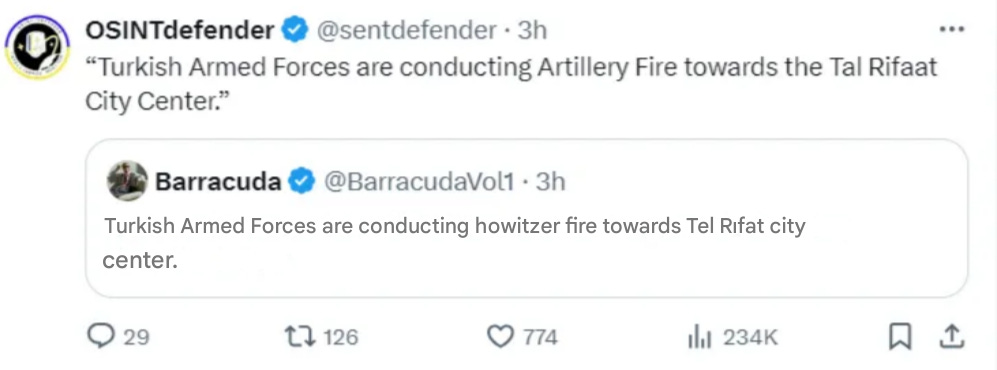
The aim seems obvious: Israel had hoped to defeat Hezbollah and thus eliminate Iran’s influence. But having lost, Israel has gone to Plan B, which is to eliminate Iran’s ability to resupply Hezbollah via Syria. To do that, Assad must fall. Not one to waste an opportunity, Erdogan appears to have played along for his own gains. Israel’s handprint on the attack was obvious this morning when SAA was hit with a major “exploding beeper and radio” attack, wounding many SAA servicemen—a perfect replay of the same attack on Hamas earlier.
The Empire as a whole—which includes the US and UK—have of course activated all their terrorist sleeper cells to assist the offensive because it serves them to keep Iran and Russia busy, particularly vis-a-vis Ukraine. Reports already claimed that Russia was forced to send various reinforcement contingents to Syria, which obviously stands to weaken Russia’s Ukrainian efforts. This includes a new general.
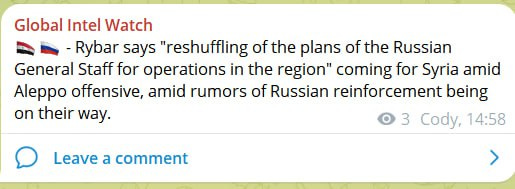

It’s clear that the conflict is taking on a global proportion of interconnectivity, a true ‘world war’, just not in the schizo-panic sense of nuclear armageddon. But rather where the world has self-assembled and divided into clear ideological camps that are increasingly entrenching themselves amongst each other out of necessity, pushed deeper and deeper into outright military alliances as is the case with Russia, North Korea, Iran, and China, or in the case of Ukraine’s deepening integration with NATO.
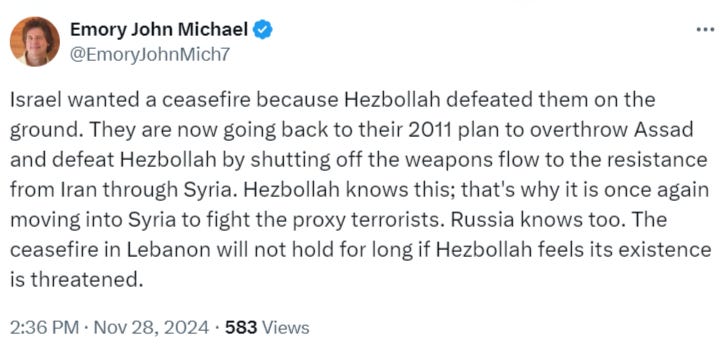
BELOW, THE HTS TERRORISTS DEPLOY TO ALEPPO VICINITY...AND THEN THEY ARE GIVEN A PROPER WELCOME BY THE RUSSIANS—(And the Western media are also up to their usual lies!). Examine the Tweets below:
Russia is already back to 'bombing hospitals' in Syria.
Deja vu all over again! https://t.co/TnlEEOHV6I— SIMPLICIUS Ѱ (@simpatico771) November 30, 2024
The HTS terrorists arrive—they seem to encounter little resistance....
AI dub: "We thank Israel for weakening Hezbollah." pic.twitter.com/MOUmVPjoeI
— SIMPLICIUS Ѱ (@simpatico771) November 30, 2024
THEN...kaboom! Russia says Hello!
By the way, some purport that the Syrian “revolution” which spawned the conflict in 2011 was in fact hatched immediately following the analogous 2006 Lebanese war and ‘ceasefire’, for the very same reasons: Israel was shocked to realize that they could not defeat Hezbollah on the ground and that Hezbollah stood to only grow more powerful in the future. As such, its conduits for support had to be excised, and thus Syria needed to be wrested from the arms of Iran. Of course, it’s never just one thing: Israel’s interests happened to dovetail with many others, including those of the Gulf Arabs, Turkey, the US and its GWOT proxy, etc.
And just as everything repeats, the Georgian color revolution, too, is mimicking the Ukrainian one:
The situation in Georgia, which decided to return to the policy of national interests, is very reminiscent of the situation in November 2013 in Ukraine.
Just like in Ukraine after the freezing of the procedure for "joining the EU" (in Ukraine at that time the Free Trade Agreement was signed), "protesters" took to the streets demanding the resignation of the newly elected Parliament, which, by the way, confidently won.
The same methods, the same demands, the same protests, which, years later, were recognized by European politicians as a deliberate overthrow of the government.
It is likely that Georgian politicians have learned the lessons of the Ukrainian Maidan and are in no hurry to turn their country into a southern anti-Russian bridgehead. Since the beginning of the SVO in Ukraine, Georgia has become a major trade hub and earns good money on trade with Russia. They remember well what Russophobia leads to - the loss of territory and economic decline.
I do not rule out that there are some tacit agreements between our countries, despite the formal absence of diplomatic relations, because Georgian goods are freely sold in Russia, and trade turnover has only grown in the last 2 years.
Georgia's turn towards normalizing relations with Russia can only be welcomed, and therefore we will hope that the Georgian leadership will have enough strength and support to prevent a Ukrainian scenario at home.
As of now, claims of Aleppo having entirely fallen turned out to be a psyop by sleeper cells which took photos deep inside the city, claiming those areas were ‘captured’ to sow panic.
Sputnik correspondent in Aleppo: Security services arrest a group of sleeper cells with another group that infiltrated one of the neighborhoods of western Aleppo city, "New Aleppo - Al-Zahraa Association", and they filmed videos and photos and spread rumors to suggest that armed terrorist groups took control of large parts of the city's neighborhoods. Cautious calm continues in the neighborhoods of western Aleppo until close to midnight. Large military reinforcements arrived in the neighborhoods of Aleppo city.
But the below maps still show the vast area of many dozens of kilometers captured west of Aleppo in a matter of days:
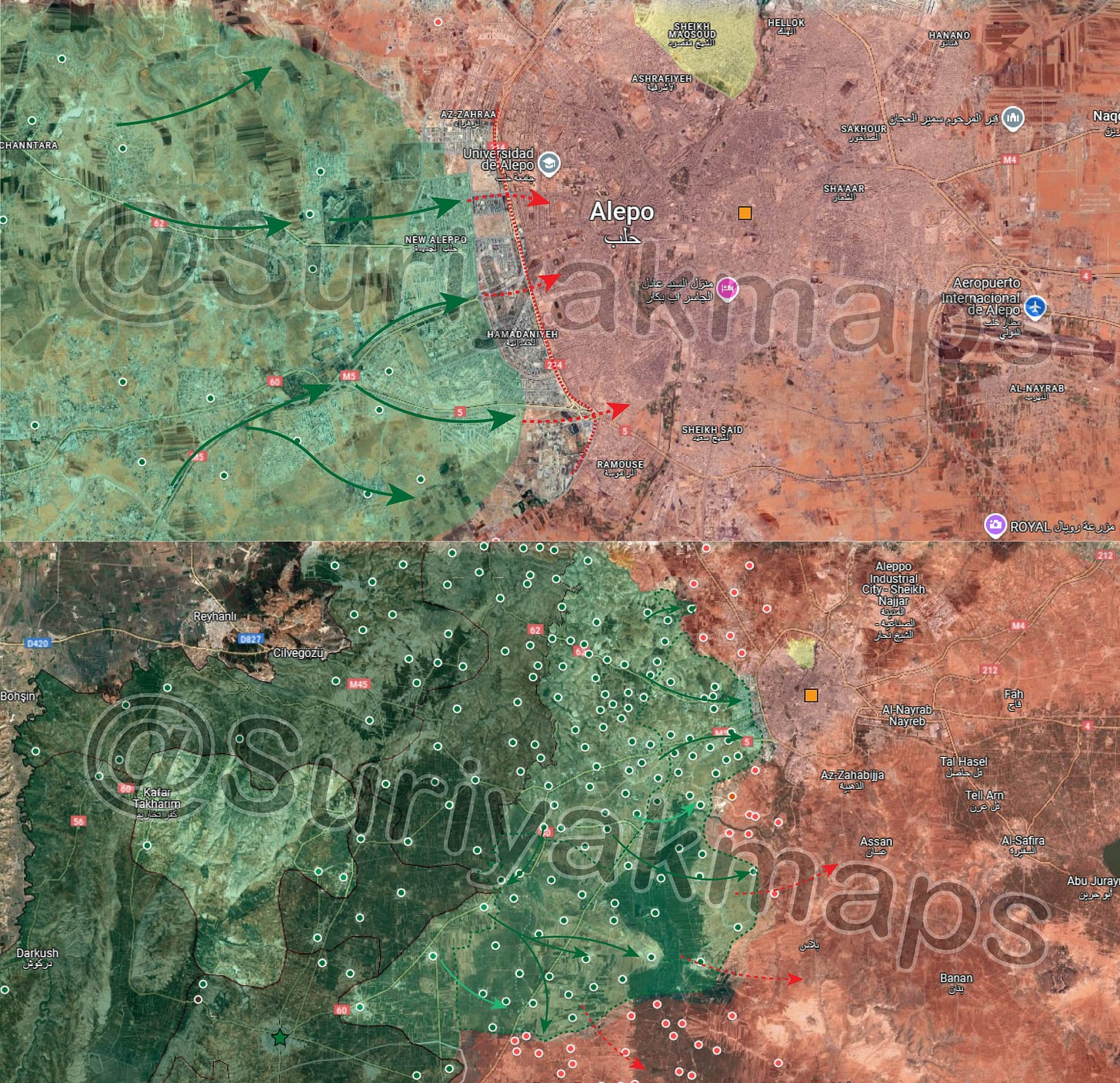
This followed weeks of Israeli strikes into Syria itself, which was clearly the preparatory forewarning, weakening Syrian forces in anticipation of this offensive.
However, the Russian airforce is said to be carrying out massive raids with MOD claiming over 400+ terrorists already killed. At the same time large amounts of SAA, Kurd, and even Iraqi Kataib Imam Ali special force reinforcements are streaming in, but we’ll see if any of it is timely enough to stabilize the situation, as threats of new fronts being opened remain.
Russian airstrikes are getting closer and closer to Turkish military presence. Footage shows Russian attacks against Arihah, just 2km from the Turkish base at Kafr Lata.
Lastly, Ukraine’s calling cards were also visible, not only with the Syrian terrorists’ trained usage of FPV drones in the attacks, but their telling choice of yellow and blue head and arm bands:
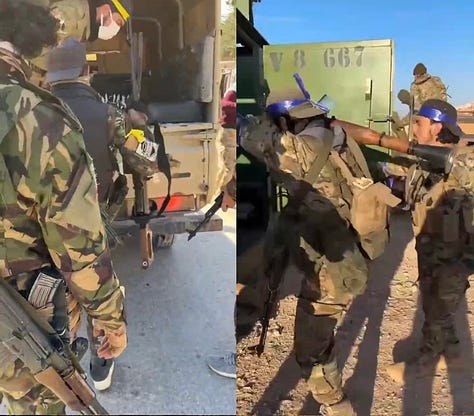
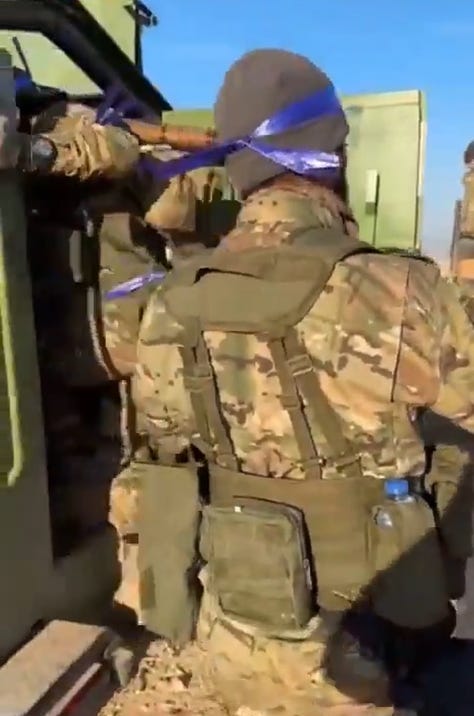
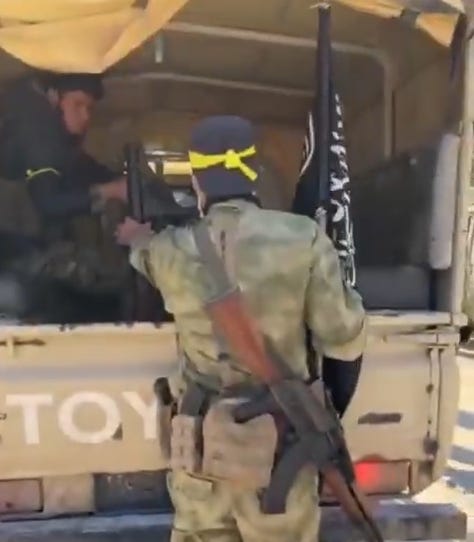
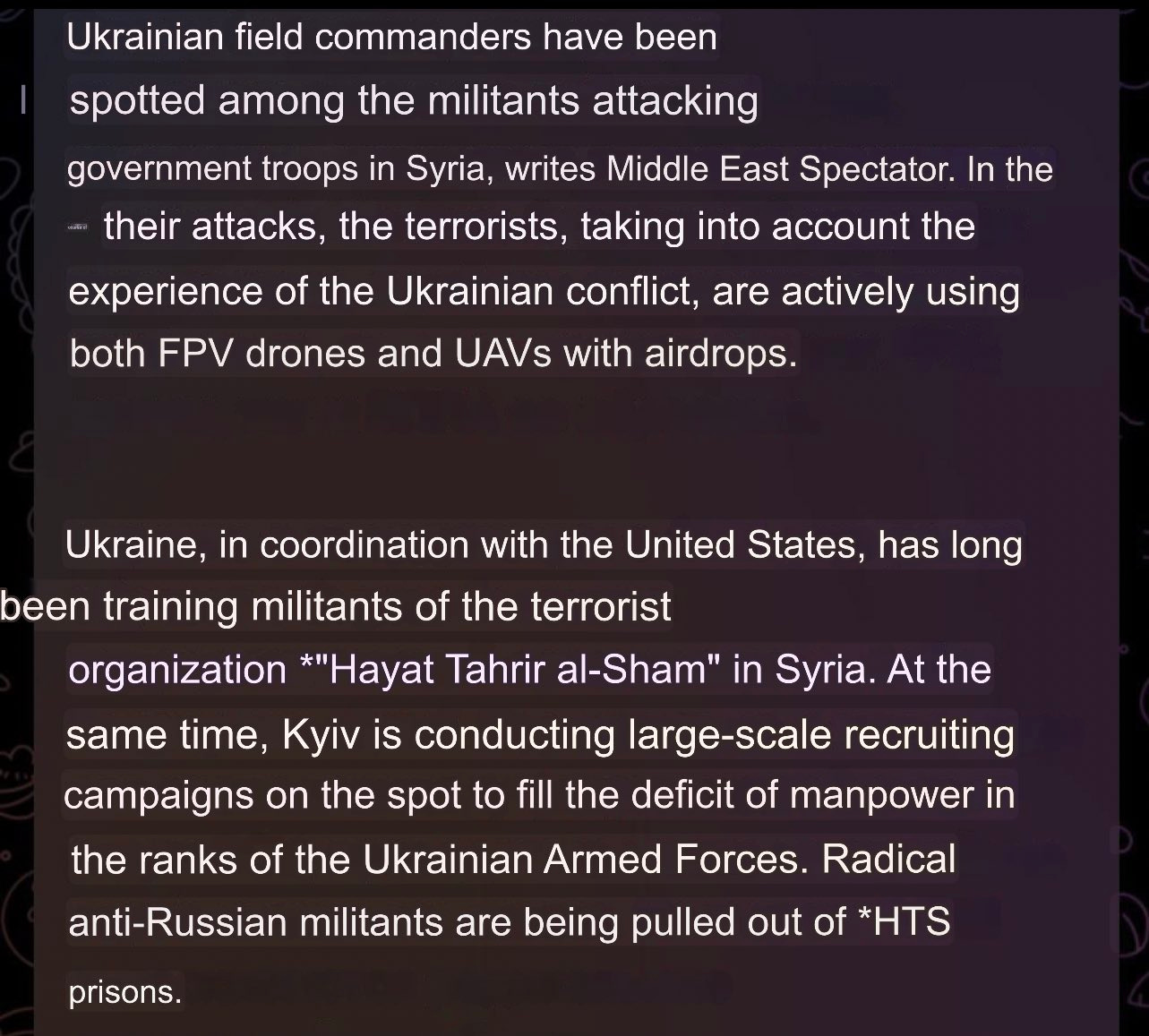
A reminder as we enter the next phase of global hybrid warfare:
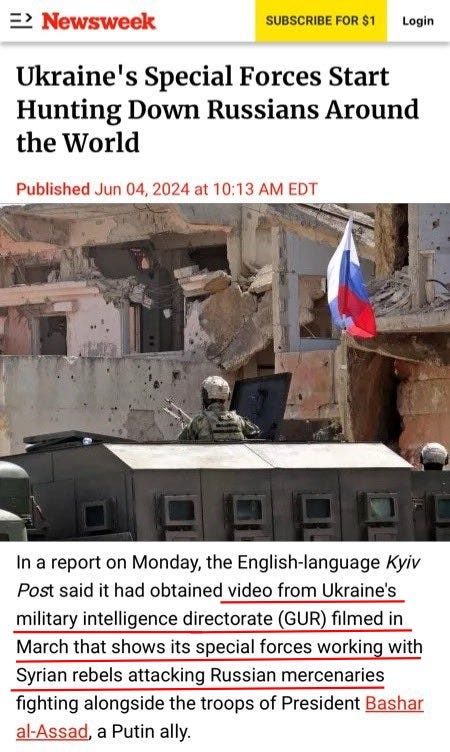
As a last note, one consideration for the offensive is also Trump’s victory. Just like Israel appeared to take advantage of Biden’s total absence from duty—an empty and wayward White House run by low level State Dept apparatchiks—in launching its various terror, genocide, and war campaigns against Gaza and Lebanon, now too Turkey may have realized time is ticking. Not only has Trump verbalized a desire to withdraw US troops from Syria—albeit with a caveat to be discussed another time—but he’s nominated famed “Assad apologist” Tulsi Gabbard to the extremely powerful DNI role. Turkey and Israel both may sense that their chance to topple Assad and inflict a fatal wound on Syria could be running out before Trump reshuffles the cards.
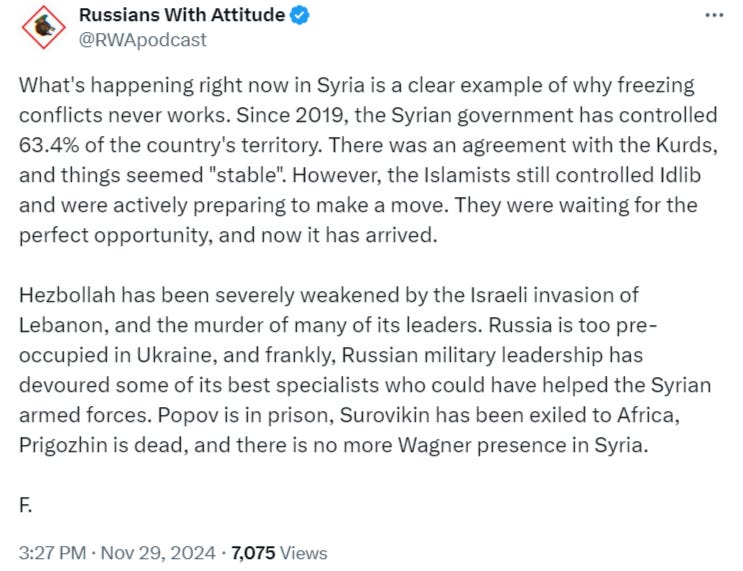
While the above is true, I don’t think Russia and Assad had too much choice in freezing the Syrian conflict; there were far too many exigencies and nuances which necessitated it. However, it still serves as extremely timely and poignant cautionary tale against freezing the Ukrainian conflict. It’s clear that the side of a frozen conflict that has less to lose always has the advantage. For instance, in Syria’s case, society returned to normality which allowed troops to be dismissed, command to relax, because Syria is a normal aspirant country, with citizens that seek to grow and improve their lives. But in the terrorist dens of places like Idlib, all the militants could do was seethe and stew in their extremist resentment while fashioning grand vengeance plans at the expense of productive existences.
The same will happen in Ukraine. After a freeze, Russia—being a normal country—is much more disposed to return to a state of disarmed relaxation and forward-looking productivity, while Ukraine will be broken and consumed in its plans for retribution for years to come, if need be, planning to finally one day catch Russia subdued and off guard.
As such these barbarous forces always have the upper hand in patience and the element of surprise against developmentally superior countries seeking a return to status quo normalcy, economic growth, and social development.
Your support is invaluable. If you enjoyed the read, I would greatly appreciate if you subscribed to a monthly/yearly pledge to support my work, so that I may continue providing you with detailed, incisive reports like this one.
Alternatively, you can tip here: buymeacoffee.com/Simplicius
Print this article
The views expressed herein are solely those of the author and may or may not reflect those of The Greanville Post.
 This work is licensed under a Creative Commons Attribution-NonCommercial 4.0 International License •
This work is licensed under a Creative Commons Attribution-NonCommercial 4.0 International License •
ALL CAPTIONS AND PULL QUOTES BY THE EDITORS NOT THE AUTHORS




